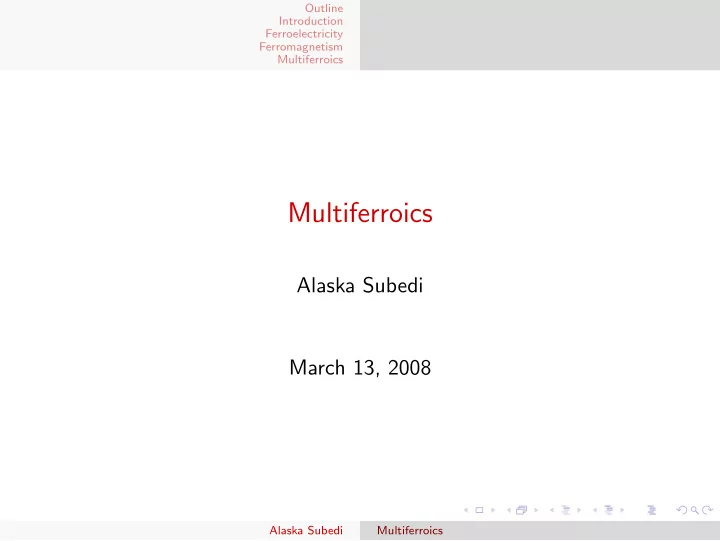

Outline Introduction Ferroelectricity Ferromagnetism Multiferroics Multiferroics Alaska Subedi March 13, 2008 Alaska Subedi Multiferroics
Outline Introduction Ferroelectricity Ferromagnetism Multiferroics Outline Introduction 1 Ferroelectricity 2 Ferromagnetism 3 Multiferroics 4 Alaska Subedi Multiferroics
Outline Introduction Ferroelectricity Ferromagnetism Multiferroics What are multiferroics? Materials that manifest both ferroelectricity and ferromagnetism. ??? Alaska Subedi Multiferroics
Outline Introduction Ferroelectricity Ferromagnetism Multiferroics What are ferroelectrics? Materials that show instantaneous electric dipole moment. Used in capacitors and computer memories. Derives from the fact that electrons posses charge. E.g. perovskite structured oxides such as PbTiO 3 and BaTiO 3 . Alaska Subedi Multiferroics
Outline Introduction Ferroelectricity Ferromagnetism Multiferroics Perovskite Structure Figure: Cubic perovskite structure. The white circles at the corners represent A, grey circles represent O and black circle represents B. Alaska Subedi Multiferroics
Outline Introduction Ferroelectricity Ferromagnetism Multiferroics Ferroelectricity Above T c : a normal dielectric. Below T c : spontaneous polarization. Below T c there is a structural distortion which moves cation B slightly away from the center of the octahedral cage. There is competition between Coulomb repulsion between atoms and bonding consideration due to hybridization of orbitals. At high temperatures, the Coulomb repulsion dominates. Below the transition temperature, forces associated with stabilization of polarized bonding dominate. Alaska Subedi Multiferroics
Outline Introduction Ferroelectricity Ferromagnetism Multiferroics What are ferromagnets? Materials that possess instantaneous dipole magnetic moment. The usual magnets. Also used in computer memories. Derives from the fact that electrons posses spin. E.g. Fe, Co, Ni, MnSb, MnAs. Alaska Subedi Multiferroics
Outline Introduction Ferroelectricity Ferromagnetism Multiferroics Ferromagnetism Above T c the dipole moments of atoms are arranged haphazardly. Below T c the dipole moments of atoms arrange themselves in the same direction causing spontaneous magnetism. The dipole moment in the atom is caused by the spin of electrons in partially filled orbitals. Alaska Subedi Multiferroics
Outline Introduction Ferroelectricity Ferromagnetism Multiferroics Curie-Weiss theory of ferromagnetism Exchange energy favours electrons with parallel spins. Above T c , thermal energy is larger than exchange energy. Explains ferromagnetism in most materials but fails to predict correct magnetic moment per atom. Also incorrectly predicts magnetic moment in each atom to be the same in both ferromagnetic and paramagnetic case. Alaska Subedi Multiferroics
Outline Introduction Ferroelectricity Ferromagnetism Multiferroics Stoner theory of ferromagnetism The difference between adjacent band energies compete with exchange energy. Exchange energy favours one band to be occupied with electrons of only one type of spin. Alaska Subedi Multiferroics
Outline Introduction Ferroelectricity Ferromagnetism Multiferroics Stoner theory of ferromagnetism Figure: 3d and 4s up- and down-spin densities of states in some transition metals Alaska Subedi Multiferroics
Outline Introduction Ferroelectricity Ferromagnetism Multiferroics Multiferroics Materials that show both spontaneous electric dipole moment and magnetic dipole moment. Could be used in multistate data storage or novel memory media which allows simultaneous reading and writing of data. Unfortunately very few multiferroic materials. E.g. BiFeO 3 , Pb(Fe 1 2 Nb 1 2 )O 3 , YbMnO 3 , etc. Alaska Subedi Multiferroics
Outline Introduction Ferroelectricity Ferromagnetism Multiferroics Limiting factors in simultaneous existence of ferroelectricity and ferromagnetism Symmetry There are thirteen point groups that allow both ferroelectricity and ferromagnetism. Electrical Properties Ferroelectric materials must be insulators. Ferromagnets are are often metallic. Chemistry Ferroelectric materials have ions in a d 0 state. Ferromagnets have partially filled d orbitals. Alaska Subedi Multiferroics
Outline Introduction Ferroelectricity Ferromagnetism Multiferroics Why so few multiferroics? Insulators vs. metallic d orbital status Perhaps ions with partially filled d orbitals are simply too large to move away? Alaska Subedi Multiferroics
Outline Introduction Ferroelectricity Ferromagnetism Multiferroics Multiferroic BiMnO 3 Figure: Density of states for cubic paramagnetic LaMnO 3 and BiMnO 3 . Alaska Subedi Multiferroics
Outline Introduction Ferroelectricity Ferromagnetism Multiferroics Multiferroic BiMnO 3 Figure: Density of states for cubic ferromagnetic LaMnO 3 and BiMnO 3 . Alaska Subedi Multiferroics
Outline Introduction Ferroelectricity Ferromagnetism Multiferroics Multiferroic BiMnO 3 Table: Eigenvectors and eigenvalues of the dynamical matrix that correspond to the unstable phonon modes in cubic paramagnetic BiMnO 3 and LaMnO 3 . ν (cm − 1 ) Material Bi Mn O z O x O y √ √ BiMnO 3 72.39 i 0.0 0.0 0.0 -1/ 1/ 2 2 BiMnO 3 98.20 i -0.43 0.09 0.16 0.62 0.62 √ √ LaMnO 3 49.04 i 0.0 0.0 0.0 -1/ 1/ 2 2 LaMnO 3 44.69 i -0.59 0.22 0.21 0.53 0.53 Alaska Subedi Multiferroics
Outline Introduction Ferroelectricity Ferromagnetism Multiferroics Conclusions Multiferroics are materials that show spontaneous electric and magnetic polarization. The scarcity can be explained by the fact ferroelectricity and ferromagnetism compete with each other. In some materials these competing factors can be balanced such that it shows both electric and magnetic properties. Alaska Subedi Multiferroics
Recommend
More recommend